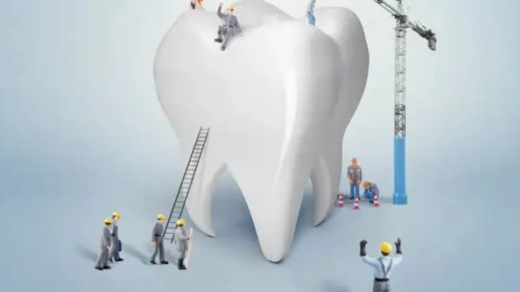Table of Contents[Hide][Show]
Cracked teeth are the third most common reason for tooth loss.1 But when it comes to your teeth, a crack is not just a crack.
You may have what looks like cracked teeth, but it may just be a craze line or craze fracture. Cracked teeth may be an emergency, but a craze line is a cosmetic issue.
Dentists often find it challenging to define cracks in teeth. There are so many different degrees of cracked teeth, with each one requiring a unique solution.
In this article, we will discuss what craze lines and craze fractures are. We will also look at symptoms, causes, and how to treat them, including whether you can use hydroxyapatite for treatment.
What are craze lines?
Craze lines are superficial lines with slight vertical splits in the outer layer of the teeth enamel. They are sometimes called hairline cracks or superficial cracks.
While craze lines don’t affect your physical health, you may find that their visibility makes you unsatisfied with your smile.
In smokers or coffee drinkers, craze lines may appear as stain lines on your teeth.
What causes craze lines?
Craze lines can occur due to the normal aging of the teeth—from wear and tear over time.
Craze lines can also be caused by:
- Grinding of teeth. Rapidly-formed craze lines could be the result of teeth grinding.
- Sleep bruxism. The hallmarks of sleep bruxism, a sleep-related movement disorder, are teeth grinding and clenching, which can lead to craze lines.2
- Bad habits. If you constantly bite your fingernails or chew gum, these bad habits can lead to craze lines.
- Orthodontics gone wrong. If your teeth are not positioned properly after an orthodontic procedure, it could lead to the formation of craze lines.
Craze lines vs. craze fractures
Craze lines that go deeper are called craze fractures. Deep fractures are dangerous because they may be colonized by bacterial biofilms. Dentists often take out fillings to see how deep the lines have gone.
When you bite on a fractured tooth, you may feel pain. Over time, the crack can propagate and affect the pulp, and you can end up with a dying tooth.
In many cases, cracks that extend to the pulp can cause symptoms ranging from acute inflammation to total pulpal necrosis.3 You may need an intervention that prevents the crack from propagating further.
Trauma can also cause your upper and lower jaw to hit together and cause a craze fracture in your tooth.
What are the symptoms of craze lines and craze fractures?
Patients experience different symptoms that may or may not indicate craze lines.
A crack that doesn’t show any signs or symptoms, such as hot or cold sensitivity, is probably a craze line. You shouldn’t worry about it but point it out to your dentist.
However, if you’re experiencing pain when you bite or chew, you may have a craze fracture.
How can dentists help treat craze lines?
Regular visits to your dentist can help identify a craze line or deep fracture.
When you go to your dentist, he or she may use dental imaging technology known as indocyanine-green-assisted near-infrared fluorescence (ICG-NIRF) to detect any cracks in your enamel. ICG-NIRF can also detect issues like dental caries and decays.
During ICG-NIRF dental imaging, the enamel is illuminated with light at the excitation wavelength of about 750-800 nm, and then it is observed at longer wavelengths of over 800 nm.4 ICG is great because it is non-toxic and nonionizing.
If you think you have a craze line, the first thing you should do is schedule an appointment with your dentist. You don’t want that craze line to deepen and become a craze fracture.
Unfortunately, if the fracture goes below the gum line or to an area that we cannot reach, like a restoration with a crown and filling, it will leak bacteria, affect the pulp, and result in bone loss. So don’t let that fracture propagate below the gum line, or we will not be able to extract it.
Craze lines are harmless, but if you insist on treatment, your dentist may offer the following cosmetic procedures:
- Teeth whitening. This works best if your craze lines are stained. Smokers and coffee drinkers may benefit from teeth whitening. Teeth whitening will not remove craze lines but will improve their appearance.
- Porcelain veneers. Dental porcelain veneers are made up of thin shells that can bond directly to your teeth. They can mask stains just like teeth whitening but are more durable. Porcelain veneers also need to be custom-made for each tooth.
- Cosmetic bonding. Dentists can use something called composite resin to mask the appearance of craze lines. Cosmetic bonding is more affordable than porcelain veneers.
Can you use hydroxyapatite toothpaste to heal craze lines and fractures?
The short answer is, “no.” Fluoridated or hydroxyapatite toothpaste cannot seal craze lines. Hydroxyapatite toothpaste is beneficial for remineralizing damaged teeth. However, remineralization cannot occur in craze lines or fractures because they are constantly moving.
However, as a functional dentist, I recommend regular use of hydroxyapatite toothpaste and not fluoridated toothpaste. Although more people are becoming aware of the ingredients they cook with, they do not check for the ingredients in their toothpaste brand.
Unfortunately, adults and children are constantly exposed to toxic ingredients in their homes or places they visit frequently. Some examples of harmful metals and chemicals are lead, mercury, arsenic, glyphosate, and chemicals found in air pollution.
It’s nearly impossible to control the level of exposure to all of these toxic ingredients. But when it comes to fluoride, it’s a no-brainer: you can replace fluoride in toothpaste with hydroxyapatite.
What exactly is hydroxyapatite?
You may be wondering what hydroxyapatite is and why it’s in toothpaste.
Hydroxyapatite, in its natural form, is a form of calcium that makes up 97% of your tooth enamel and 70% of the dentin of your teeth. The rest of your enamel is actually composed of water, collagen, and other proteins.
The beauty of hydroxyapatite is that we don’t have to take away something that prevents decay—we have a replacement that isn’t toxic, is biomimetic, and has proven to be safe.
You can heal cavities and prevent new ones from forming by remineralizing your teeth. Hydroxyapatite is one very effective way to do that.
Hydroxyapatite performs just as well as fluoride, in some cases better, with none of the toxicity concerns.
Conclusion
Craze lines and fractures are difficult to diagnose, but through careful examination, your dentist can determine what you’re dealing with.
If you think you are experiencing pain because of a craze line or fracture, tell your dentist.
Hydroxyapatite or fluoride will not heal your craze lines or craze fractures. However, consider using hydroxyapatite toothpaste for other advantageous properties.
Regular visits with your dentist will be beneficial in case you need an intervention for your craze lines or fractures.
References
1. Li Z, Holamoge YV, Li Z, et al. Detection and analysis of enamel cracks by ICG-NIR fluorescence dental imaging. Ann N Y Acad Sci. 2020;1475(1):52-63. doi:10.1111/nyas.14374
2. Bruxism (teeth grinding) – Symptoms and causes. Mayo Clinic. Accessed April 2, 2021. https://www.mayoclinic.org/diseases-conditions/bruxism/symptoms-causes/syc-20356095
3. Ricucci D, Siqueira JF, Loghin S, Berman LH. The cracked tooth: histopathologic and histobacteriologic aspects. J Endod. 2015;41(3):343-352. doi:10.1016/j.joen.2014.09.021
4. Alander JT, Kaartinen I, Laakso A, et al. A Review of Indocyanine Green Fluorescent Imaging in Surgery. Wei G, ed. International Journal of Biomedical Imaging. 2012;2012:940585. doi:10.1155/2012/940585


